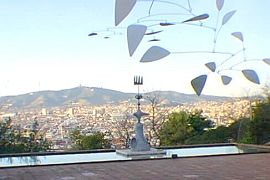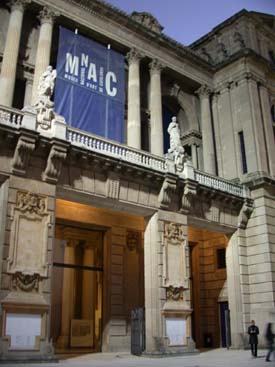
Royal Castle, Warsaw


Begun in 1916, the National Museum in Warsaw was completely rebuilt and reorganized in 1995. The traditional prewar names of museum units were reintroduced and the Sculpture Collection was renewed. There is a new Collection of East Christian and Byzantine art.
The opening of new permanent galleries, the Gallery of Italian Painting and a reorganized Gallery of Ancient Art, occured in the year 2000. Continue reading
Located in the Old Town Square in a row of completely resorted old houses, you should visit the Historical Museum in Warsaw. Visiting here is key to understanding why there are so many ghosts wandering around this city.
According to the museum’s website, the traditions of the Historical Museum of Warsaw go back to the period between War World I and War World II. The Old Warsaw Museum came to existence in 1936 and was situated in the Old Town Market Square in the tenement – houses once belonging to the Barycz-ka and Szlichting families. During the World War II the Museum shared the fate of its city and was completely destroyed during insurrection fighting in Warsaw Uprising in 1944.
After Poland’s liberation the Museum of Warsaw was created and estabilished in eleven tenement – houses in the Old Town Market Square and Nowomiejska Street reconstructed according to old plans and drawings. It has preserved the beauty of the Renaissance facades, vaults, staircases and interiors.
In 1946 the Museum didn’t have any collections yet. Because most of “varsavianas” (the items and exhibits concerning Warsaw’s history) have been destroyed during the war – efforts were made to gather and collect any relics which have been saved and could be found in Poland. Furtheremore items were acquired as deposits from other museums, especially from the National Museum in Warsaw, also many donations were made by private persons.
The Centre for Contemporary Art in Warsaw, “is a place for the creation and documentation of art in all its forms.” This is according to the museum’s own literature. They also say that the Centre for Contemporary Art achieves its goals through exhibitions, performances, presentations of visual theatre, concerts of contemporary music, showings of experimental films, video art, shows and creative workshops, as well as various interdisciplinary events. The Centre has been in existence for 12 years.
Galleries are open daily except Mondays
from 11 am – 5 pm and Friday from 11 am – 9 pm
Tickets: full-fare 10 zl and concessions: 5 zl
(Last visitors admitted half an hour before closing time of galleries)
Kino.Lab Cinema – tickets: 12-16 zl;
three-month pass: 100 zl; one-year pass: 300 zl
Continue reading
The Barcelona Picasso Museum was donated to the city of Barcelona by the artist. He trained as an artist here, and what he experienced here opened him up for him the path that he followed in the modern art world.
The museum has a collection of works by Picasso from between 1895 and 1904, the years in which the he lived in Barcelona.
The Picasso Museum occupies five medieval palaces: Aguilar, Baró de Castellet, Meca, Casa Mauri, and Palau Finestres, which have been restored various times throughout the centuries.
Located in the Ciutat Vella district of Barcelona. Taking a cab is the best way to get here.
Address: C Montcada, 15*23
08003 Barcelona
Phone: 933 196 310
Fax: 933 150 102
Website: https://www.museupicasso.bcn.es
Email: museupicasso@mail.bcn.es

This wonderful museum displays more than 150 works by the noted surrealist/abstractionist, Joan Miró, including paintings and sculptures. The museum is itself a work of art and stands on a hill overlooking Barcelona, surrounded by beautiful views of the city.
 Miró’s works stand alongside those of his contemporaries and friends like Calder, Moore, and Max Ernst. The foundation also features temporary exhibitions and concerts.
Miró’s works stand alongside those of his contemporaries and friends like Calder, Moore, and Max Ernst. The foundation also features temporary exhibitions and concerts.
This museum is a must for those who love abstract art!
Location: Avinguda Miramar 71, Parc de Montjuïc
08038 Barcelona
Phone: +(34) 93 329-1908
Fax: +(34) 93 329-8609
Open Tues,Wed,Fri,Sat – 10am-7pm
Thurs – 10am-9:30pm
Sun – 10am-2:30pm
Entrance adults: € 7.20 reduced rate: € 3.90
Website:https://www.bcn.fjmiro.es
High above Barcelona in Parc Montjuic is the Palau Nacional de Montjuic, home to the Museu Nacional D’Art De Catalunya, and filled with 19th and 20th century artworks.

This elegant palace is home to a permanent collection of Romanesque art, Catalunyan Gothic art, European masters collections including the renaissance and the baroque periods. Modernisme, Noucentisme, Avant-Garde and more are to be found here.
Temporary exhibits of paintings, coins, sculpture, photography and more come and go, supplementing the extensive collection of art in the palace.
Take the time and spend a day on Montjuic exploring the world of art in Catalunya.
Open: Daily except Mondays. 10 am til 2:30 pm Sundays. 10 am to 7 pm other days.
Phone:936 220 360
The Prado museum houses one of the finest collections of classical art in the world. It was first established in 1819 as the Royal Academy of Fine Arts by King Ferdinand VII and his second wife, María Isabel de Braganza, who is considered the founder of the museum. It was nationalized in 1868, and the name was changed to Museo Nacional del Prado.
The museum’s collections, including 8,600 paintings are so large only about one-seventh can be put on display at one time. The collections include the works of great Flemish, Dutch, French, Italian, German and of course Spanish masters.
One of the most famous paintings in the museum is the Garden of Earthly Delights by Hieronymous Bosch, one of many works “acquired” by Spain during it’s rule of the low countries.
Plan on spending at least one day visiting these masterpieces.
More info:
Museo Nacional del Prado
Paseo del Prado s/n. 28014 Madrid
Administrative offices
Ruiz de Alarcón 23. 28014 Madrid
Tel.: 00 34 91 330 28 00
Fax: 00 34 91 330 28 56
website: www.museoprado.es
email: museo.nacional@prado.mcu.es
Opening Hours: From 9am to 7pm, Tuesdays to Sundays and public holidays. (closed on Mondays). Last admission 30 minutes before closing time. Galleries emptied 10 minutes before closing time.
Admission: 6 Euros, 3 Euros reduced rate.
Free entry days:
Sundays (9am to 7pm)
12 October (Hispanidad Day)
6 December (Constitution Day)
2 May (Official Day, Region of Madrid)
18 May (International Museums Day)
Golf in the Netherlands has become big since World War Two, and courses are to be found just about everywhere in this gem of a little country.
The Amsterdam Old Course is southeast of Amsterdam and was opened in 1990.
Telephone:+31(0)206943650
The Amsterdamse course was opened in 1934, and is west of the city.
Telephone: +31(0)204977866
The Haarlemmermeersche is west of Amsterdam, in Cruquiusdijk.
Telephone: +31(0)235583124
Golfing in Poland has really taken off, since the Communists have left and all their fancy private clubs have been opened up to public use. Add to this the growing number of new courses designed recently by Westerners and you have the perfect place for a golfing holiday. Especially when you compare the low cost of playing here to perhaps, Hawaii; and the proximity to the cultural heritage nearby in Krakow and Warsaw.
So without further ado, here is a short list of course and how to contact them:
Amber Baltic Golf Club, on the island of Wolin, in Wolinski National Park. Telephone them at +48 (0)91 3265110 to make a reservation.
The Bytkowo Golf Course, located in Poznań county, is an 18 hole course. Bytkowo Golf Course is open to the public. A PGA trainee is available on site for both individual and group lessons. Club fitting and repair services are also available. Telephone +48 (0)61 6637400
First Warsaw Golf & Country Club is in Rajszew, near Jablonna, 25 km from the centre of Warsaw. This golf course has an area of 63 hectares, and is in the Wisla river valley, filled with lakes and old trees. Each of the 18 holes has it’s individual character and different difficulty that enables players to have an exciting round of golf. Telephone +48 (0)12 282 94 67
The Krakow Valley Golf & Country Club is an 18-hole Championship Course, designed by the world-class architect, California-based Ronald Fream, who belongs to the legendary team of Robert Trent Jones. The total length including the professional tee is 6518m. Krakow Valley Golf & Country Club hosts international and national golf championships. Telephone +48 (0)12 282 94 67
The courses listed above are just the most famous, and oft-used for tournaments, but are indeed beautiful. Golfing in Poland is going to be big news in the future, as there are many tournaments planned.